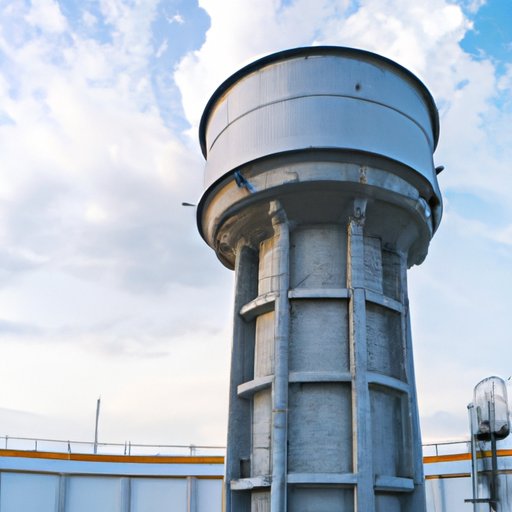Introduction
A water tower is an integral part of any water distribution system. It is a large cylindrical structure that stores water at a higher elevation than the area it serves. This allows for the efficient delivery of water to homes and businesses in the area. The purpose of a water tower is to maintain pressure in the distribution system and provide a reliable source of water for consumers.

An Overview of How Water Towers Work
Water towers work by using three main principles: storage capacity, pressure control, and gravity flow. Storage capacity refers to the amount of water a tower can hold. Pressure control is achieved by the use of pumps and valves that regulate the flow of water. Gravity flow is used to move the water from the tower down to the consumer.

Exploring the Mechanics of a Water Tower
The mechanics of a water tower involve several components. Reservoirs and tanks are used to store the water. Pumps are used to control the pressure in the system and allow for the movement of water between the reservoir and the tower. Valves are also used to regulate the flow of water into and out of the tower.

The Basics of Water Tower Functionality
The location of the tower is an important factor in its functionality. The higher the elevation, the more efficient the water delivery system will be. The capacity of the tower is also important; it must be able to meet the needs of the area it serves. The design of the tower should also be taken into consideration; different shapes and sizes can affect the efficiency of the system. Lastly, regular maintenance is essential for the proper functioning of the system.
A Step-by-Step Guide to Understanding How Water Towers Work
To better understand how water towers work, here is a step-by-step guide:
1. Locate the tank: The first step is to locate the tank. It should be placed at a high enough elevation to ensure the efficient delivery of water.
2. Connect to the main water supply: The next step is to connect the tank to the main water supply. This is typically done through pipes or underground conduits.
3. Fill the tank: Once the tank is connected to the main water supply, it can be filled with water. This is usually done by pumps.
4. Distribute the water: Finally, the water is distributed to the areas it serves. This is done through gravity flow, where the water moves from the tower down to the consumer.
Examining the Technology Behind Water Towers
In addition to the mechanics of a water tower, there is also a lot of technology involved. Automation is used to control the pumps and valves, allowing for efficient operation of the system. Sensors are used to monitor the water levels in the tower and ensure that it is always full. Monitoring systems can also be used to track the performance of the system and alert operators of any problems that may arise.
Conclusion
Water towers play an important role in the efficient delivery of water to homes and businesses. By understanding how water towers work, we can ensure that they are functioning properly and providing the necessary services. From storage capacity and pressure control to gravity flow and automation, water towers are complex systems that require careful maintenance and monitoring.
(Note: Is this article not meeting your expectations? Do you have knowledge or insights to share? Unlock new opportunities and expand your reach by joining our authors team. Click Registration to join us and share your expertise with our readers.)
